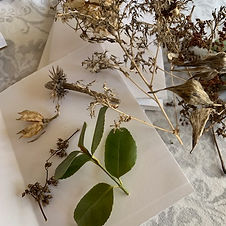
Arts - August 4, 2016
Story & Photos by Trish Crapo
The Fabric of Art - and Life
Right at the base of the Shelburne Falls side of the Iron Bridge, there’s a little shop that juts out over the water. The Print & Dye Workshop, newly opened at 2 Bridge St. around Mother’s Day, is the brainchild and heart’s passion of fabric artist Marjorie Moser.
Step in and you’ll find yourself surrounded by fabric arts in an array of rich hues and textures. There are soft silk scarves, crisp linen tea towels, free-flowing simple dresses, cloth handbags and plump pillows.
Fabric designs range from detailed silkscreened imagery, often adapted from vintage etchings, printings of natural branches and leaves, to free-flowing swirls of colors that blend like the currents of the Deerfield River visible through the shop’s windows.
Moser moved from Brooklyn to Shelburne Falls three years ago with her husband, musician and graphic artist Peter Moser. The couple has been renovating their Water Street home to include studio and workshop space.
Most of the printing and dying happens there, Moser says, but she plans to use a small back room for small dying projects and she does do some sewing in the shop. This winter, she hopes to lead a few workshops there.
Moser also stocks the shop with her own handcrafted Water St. Soaps, a line of handcrafted candles, and jewelry designed by Donna Wagner.
Moser started screen-printing early.
“I cut chemistry in high school and went to graphic arts and learned it,” she says with a smile. “And ever since I’ve been wanting to learn more about how to put pattern on fabric.”
Moser went on to have a successful and varied career in printmaking, which included creating screen-printed textiles for Broadway productions.
That first Broadway job was a fluke, Moser said.
“I was doing whatever work I could get. I did a giant Plexiglas American Express card for a commercial. I did a Domino’s pizza box for a commercial.”
And then someone suggested her for an unusual job.
“I met with William Ivey Long’s office, and some of their designers there showed me this Raoul Dufy print and said, ‘Can you make a print out of this for us because we want to make a bathrobe out of it for Private Lives.’”
Moser laughs. “I said, ‘Yeah, I can do that.’”
She came home, talked with her husband and the two quickly collaborated on how to replicate the French Fauvist painter’s image onto fabric, including building a special table in the basement of their Brooklyn apartment to accommodate the work’s large scale.
“By the weekend, we were ready to take the job,” Moser recalls.
That first job led to others, each of which called upon Moser to think on her feet and come up with creative solutions.
For a production of Sunset Boulevard, for instance, Moser was asked to create new fabric designs based on vintage ties.
“I met with a tie-maker down on Grant Street, and he showed me how ties have to be printed on the bias,” Moser says. “In everything that I did, I learned a little more about the business.”
For instance, workers at a wallpaper print shop below a studio space she rented in Hoboken, N.J., taught her how to set up repeating patterns. Each skill she learned expanded her expertise and her enthusiasm for fabric printing.
About 7 or 8 years ago, Moser began to explore using dyes, rather than inks, to create new fabric designs, and became enamored with a Japanese style of printing called “shibori” — what we commonly think of as tie-dye is a variation of this ancient technique, Moser says.
In shibori dying, patterns are made by tying, folding, wrapping, puckering and otherwise manipulating the cloth before submerging it in dye. In one variation, pieces of cloth are wrapped around poles before being dipped in the dye vats.
This was the first kind of shibori Moser tried.
“I walked up to 5th Avenue and I bought these big pieces of PVC pipe and I started making shibori in my bathtub. And it was great!”
Moser loves the unexpected results that can occur with dyes.
“The thing I love about dyes is that they will travel,” she says.
Dyes only have a certain amount of time in which to affect the cloth once they’re activated, Moser explains. And as they “travel” they get lighter. Folds or wrinkles in the cloth interrupt the dye’s progress, creating sometimes surprising affects.
“It’s almost like the dye has its own journey and I just set it up and I watch what it does,” Moser says with a smile.
Where to see it
Print & Dye Workshop, 2 Bridge St., Shelburne Falls; 413-404-3531. Hours: Monday, noon to 5 p.m.; Thursday through Sunday, noon to 5 p.m. Online: Facebook or visit the website at: www.marjoriemoser.com. Moser’s blog, “I dye every day,” at: https://mydyeblog.wordpress.com



.jpg)

.jpg)